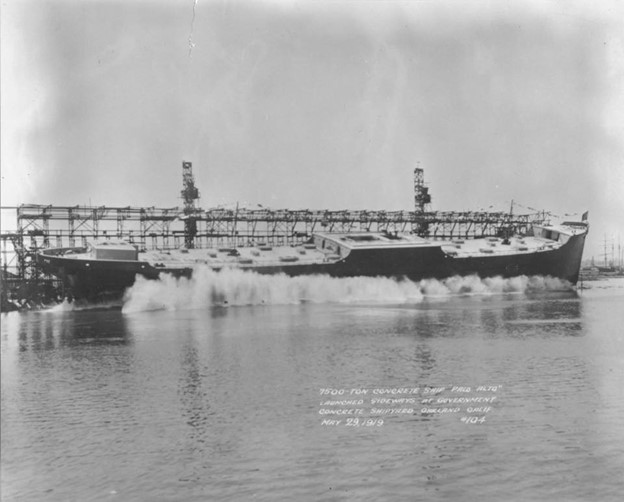
Palo Alto History
Built in 1918 as an oil tanker designed to refuel other war craft at sea during World War I, the SS Palo Alto, along with her sister ship the SS Peralta, were launched in May 1919 only months before the war ended. Measuring in at 435 feet, she cost an estimated $1.5 million to build with a 2,800 horsepower steam engine, bronze fittings, an eleven ton bronze propeller fifteen feet in diameter, a fifteen-ton rudder, decks of white Norwegian ash, and a tile-floored gallery. Due to her size, she had to be launched sideways. So at 2:15pm, on May 29, 1919, Mrs. Anna May Wig shattered a bottle of champagne against her bow, and the Palo Alto slid to starboard down the wooden ways into the water creating a sizable wave in the harbor!

Launch

Undergoing sea trials
Having failed to see service in the war, the Palo Alto languished in the U.S. Navy Shipyard in Oakland for more than a decade until the Seacliff Amusement Corp. bought the ship in 1929. After installing a dance floor, swimming pool, restaurant, refreshment booths, and other attractions, the corporation had it towed in 1930 from Oakland to Seacliff Beach where it was scuttled on the seafloor with its prow headed out to sea to split the waves.. There it would be connected to a pier leading to the beach and an access road.

Scuttled on the sea floor

Aerial view
1930 - January 21-22 – Towed from Oakland to Seacliff
1930 - January 25 – Intentionally sunk off the
end of pier
1930 - June 21 – Grand
opening
The Seacliff Amusement Corporation borrowed $28,000 to build out the rest of the pier, dig a 190-foot well for fresh water, and pave the access road down from the Watsonville-Santa Cruz Road (today’s Soquel Drive) and along the beach. The pier, measuring 630 feet long and 40 feet wide, was finished in early June 1930. On June 21, the ship’s dancehall, The Rainbow Ballroom, was opened up for a special preview event. The dancehall occupied most of the main deck and was 54-feet wide, with tall windows looking out over the Bay. Several hundred people showed up that night and danced the night away with Ed Rookledge’s 10-Piece Orchestra providing the music.
By this time, the SS Palo Alto not only boasted a casino but featured a dancehall, a swimming pool and a restaurant. Its entertainment offerings weren’t even dented by Prohibition, which technically disallowed the sales of alcohol from 1920 until 1933. The rum runners loved it as they would just pull up beside the ship and offload the booze right there.
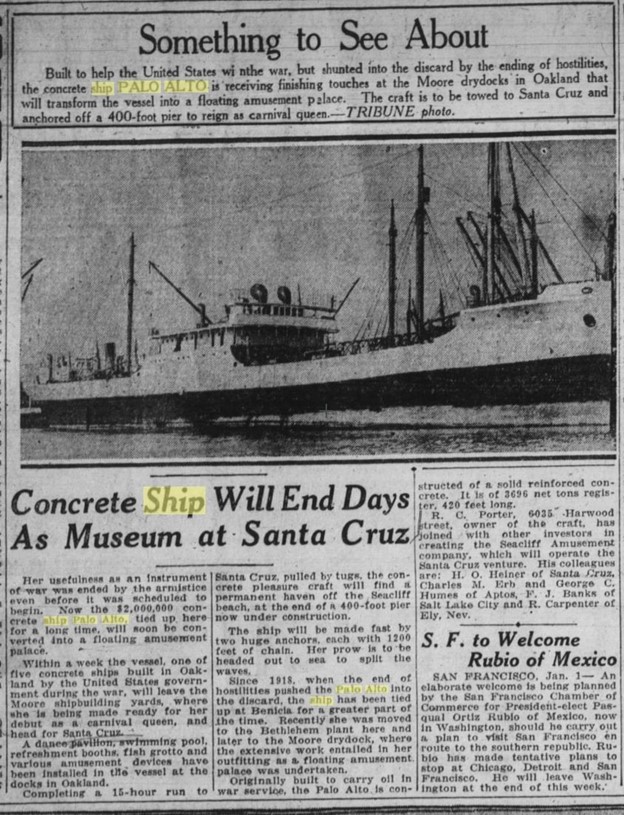
News of the day
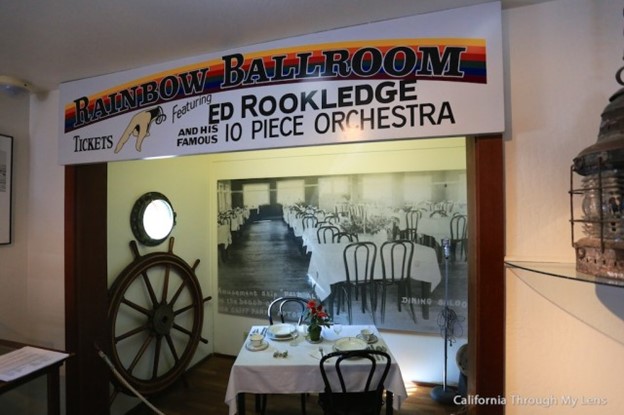



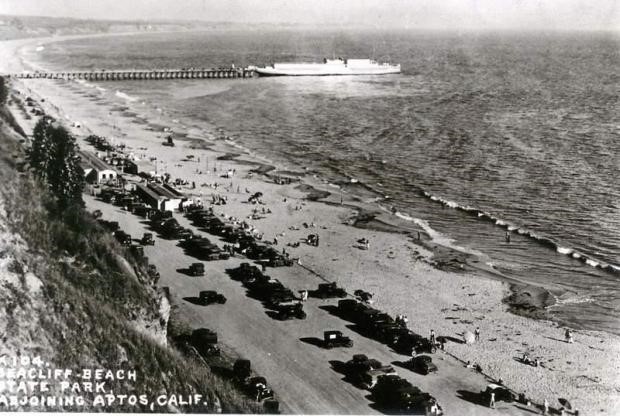
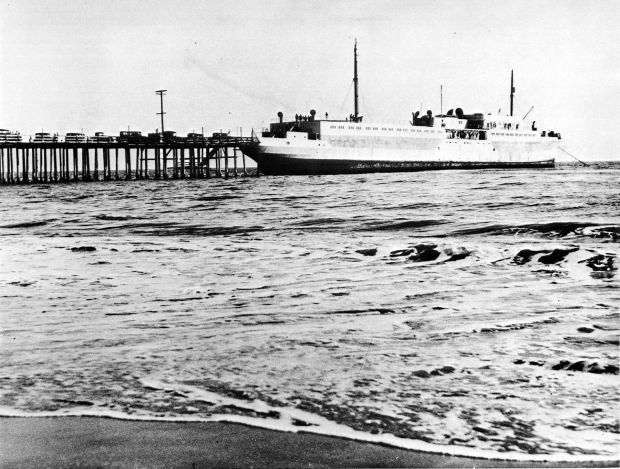
The Santa Cruz Sentinel reported that 2,000 cars visited Seacliff Beach that weekend and an estimated 3,000 people boarded the Palo Alto! It was indeed a very successful start and it appeared the Palo Alto had finally found her purpose. Sadly, just 2 years later, the Seacliff Amusement Corporation would be bankrupt and the ship’s doors would be closed for good. The dream of a resort in Seacliff was dead. Furthermore, a crack had appeared in the ship after a particularly fierce winter in the early 1930s and the corporation had had enough.
1933:

The Seacliff Corp. sold off the steel and engine parts while stripping other components and even packing up the dance floor and putting it on the open market. In 1936, the state of California bought the SS Palo Alto for $1. It was transformed into a fishing pier, extremely popular with local anglers.
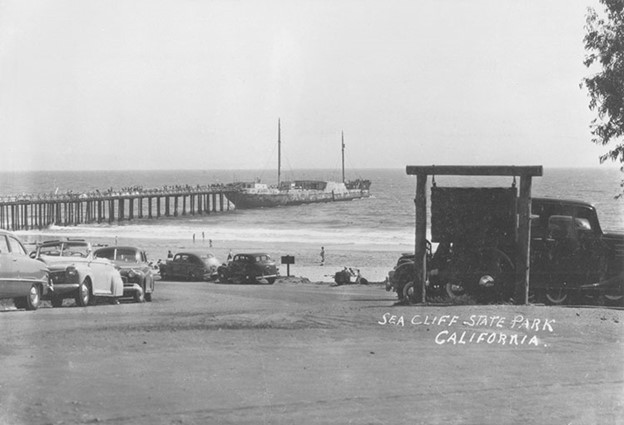
Despite owning the ship, the state didn’t take possession of Seacliff State Beach until 1948, making it one of the first state beaches incorporated into the state’s portfolio of parks.
During the 1950s, Ralph Creffield’s bait and tackle shop occupied the stern cabin. He also rented rowboats, which were stored on deck and lowered over the port side with a small crane. Creffield also had a hamburger stand in a trailer installed around 1945 towards the entrance to the pier. It was replaced with a larger wooden hamburger stand in the early 1960s and in 1983 was moved off the pier and directly across the road where it survived until 2022. It was most recently home to Marianne’s Ice Cream.
Several storms have continued to damage the old ship, including 1963 when the hull was broken off and the bow settled several feet into the sand. In January 1978, heavy storms increased the break in the hull amidships. More heavy storms in January of 1980 caused the Parks System to announce the ship would be closed indefinitely.

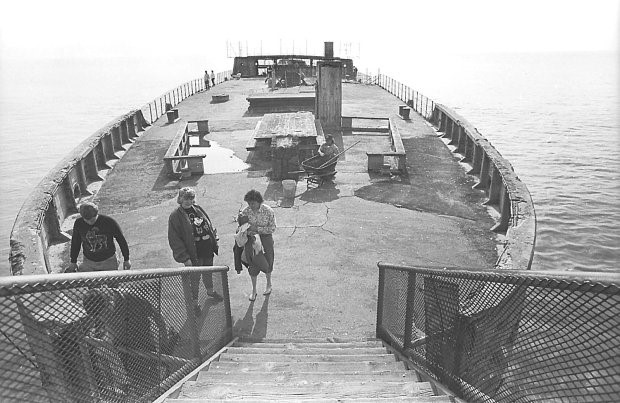
Since then, the SS Palo Alto has become further entrenched in the seafloor at the end of the pier. Continually buffeted by winter storms, the foredeck closed down in 1958. The condition of the ship faltered further forcing a temporary closure from 1983 until 1988. The permanent prohibition was handed down in 1998, but many residents remember the times when you could clamber around the scuttled watercraft.

Local fishermen (and fisherwoman), Harry Haney, Ed Nelson, and Rose Costa, decided to save the ship. With community volunteers and monetary donations, they were able to reopen the ship in July 1983. The ship remained open until October 27th, 2001, when it was announced she would be closed again.

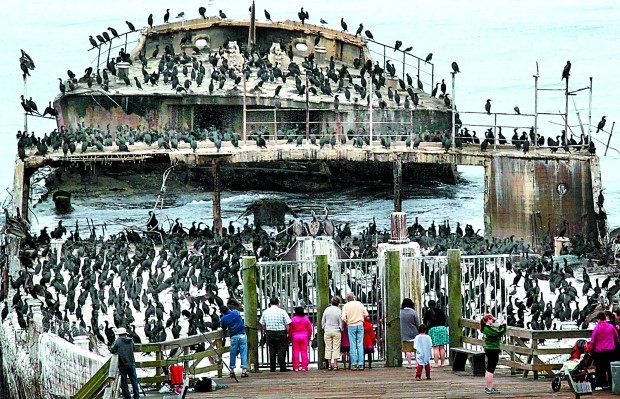
It was accessible to fishermen and pedestrians in 1993
Palo Alto was subject to a an episode of Huell Howser's TV series "California Gold" in the 1990s. At the time, the stern section was still open to the public and was still in use for sport fishing. Howser was able to explore the wreck in depth at areas normally off limits for the sake of the TV show
https://blogs.chapman.edu/huell-howser-archives/1991/11/01/ships-californias-gold-210/
https://vhost1.chapman.edu/watch_video.php?v=1035
Palo Alto 2012:
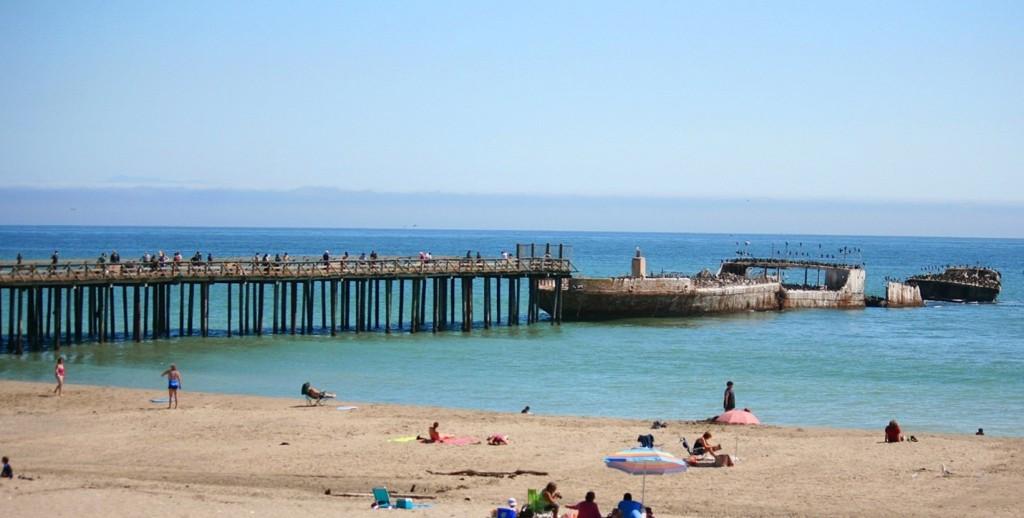
Palo Alto aerial view 2013:
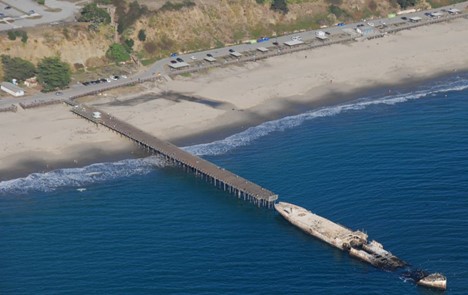
The SS Palo Alto cement ship bow shifts and continues to break up as it gets hit by large waves Thursday, Feb. 4, 2016, in Aptos, Calif. Recent El Nino storms are battering the landmark concrete ship long ago beached on the California coast, officials said Wednesday. This winter's especially powerful surf has shifted part of the fractured SS Palo Alto, causing pieces of it to break off and fall into the pounding waves. Officials say they have no plans to stop the erosion that will eventually turn the ship into habitat for sea life:

2019 Centennial:

The S.S. Palo Alto went from an oil tanker, to an entertainment ship, to a fishing pier, and will now live out the rest of her days as an artificial reef and a symbol of Aptos History (2019):
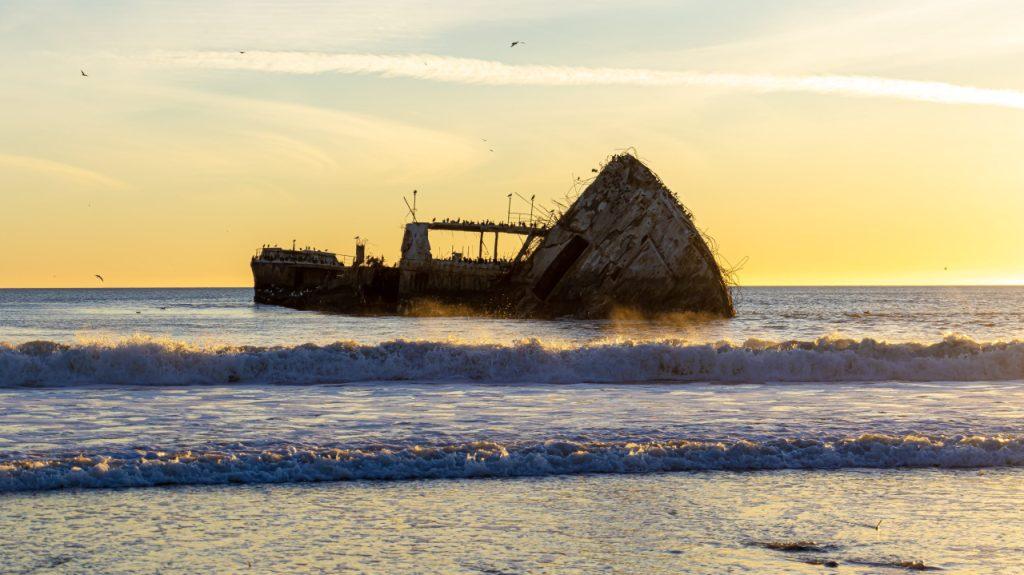
While some have called for the state to breakup and remove the ship as it continues to degrade, Griggs said removal costs would reach into the millions if not tens of millions of dollars. After an oil leak from the tanker was cleaned up in 2017. The ship functions as a valuable habitat for seabirds, sharks, rockfish, sea lions and other creatures, not to mention its historical value and persistence as a symbol of Aptos and Seacliff. See Storm 2023.
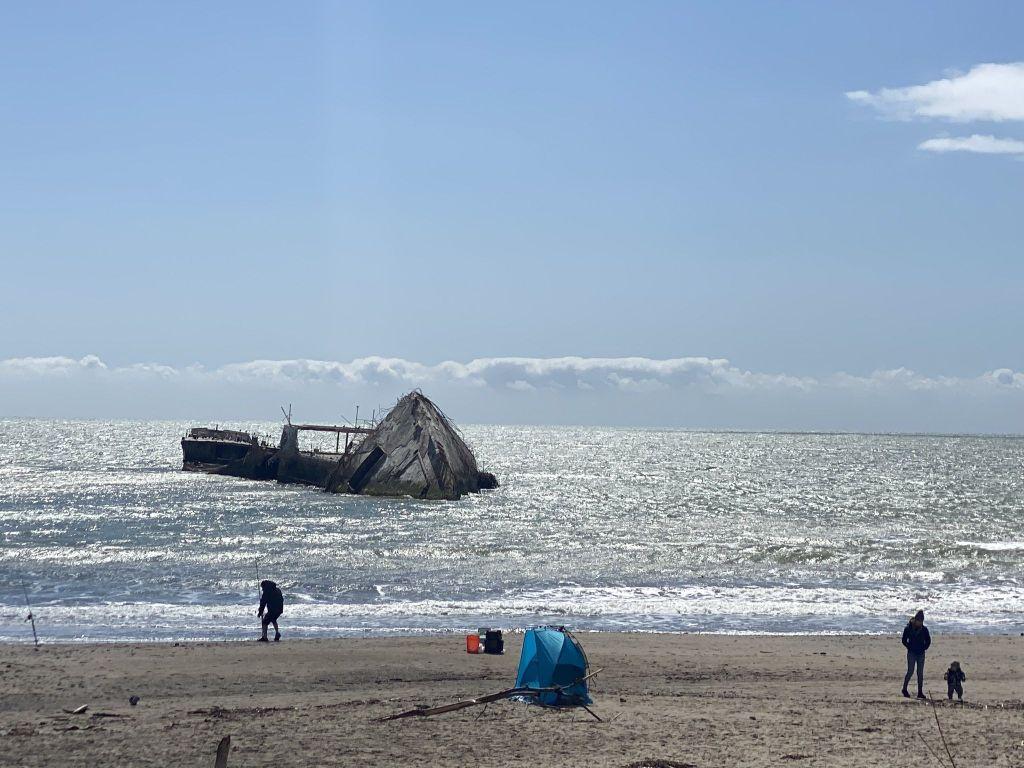
The Palo Alto without the pier, April 2023